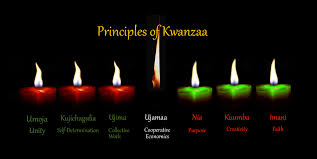Each year from December 26 through January 1 the African American and Pan African holiday Kwanzaa is observed across a seven-day celebration based on the following principles – Umoja, Kujichagulia, Ujima, Ujamaa, Nia, Kuumba, and Imani.

Each of the principles has a significant meaning that accompanies the daily lighting of the Kinara. In the center of the kinara is the Black candle that symbolizes the people, the three red candles are for the struggle or blood-shed by ancestors and the three green candles represent the abundance of possibilities the future holds. Starting with the lighting of the black candle that is known as the unity candle, the candle which is red on the immediate right is lit on the second day, the green candle which is to the left of the black candle is lit on the third day and each day staggering the right green and left red candles until day seven.
These colors were given by Civil rights activist Marcus Garvey who was also the leader of the Pan-Africanism movement. A movement that was aimed at uniting people of African descent.
The principals are as follows:
Day One – Umoja or unity.
Day Two – Kujichagulia or self-determination
Day Three – Ujima or collective work and responsibility
Day Four – Ujamaa or cooperative economics
Day Five – Nia or purpose
Day Six – Kuumba representing creativity
Day Seven – Imani or Faith
The holiday was created by Maulana Karenga, a Black nationalist, and professor of Pan-African studies at California State University at Long Beach in 1966. Kwanzaa became popular in the 1980s and 1990s with the Black Power movement. A welcome addition to the celebrated winter holidays – Hanukkah and Christmas.
You can learn more Kwanzaa and how to celebrate by visiting the website
